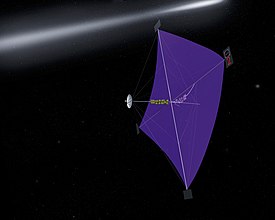Portal:Physics/Selected article/June 2008

Spacecraft propulsion is any method used to change the velocity of spacecraft and artificial satellites. Most spacecraft today are propelled by expelling a gas from the rear of the vehicle at very high speed through a rocket engine nozzle. Most current spacecraft use chemical rockets (bipropellant or solid-fuel) for launch (some, such SpaceShipOne, used jet engines in their first stage). Most satellites have simple reliable chemical thrusters (often monopropellant rockets) or resistojet rockets for orbital station-keeping and some use momentum wheels for attitude control. Soviet bloc satellites have used electric propulsion for decades, and newer Western geo-orbiting spacecraft are starting to use them for north-south stationkeeping. Interplanetary vehicles mostly use chemical rockets as well, although a few have experimentally used ion thrusters. Spacecraft propulsion systems are often first statically tested on the Earth's surface, within the atmosphere but many systems require a vacuum chamber be accurately tested.
